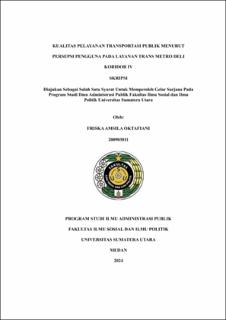| dc.description.abstract | Trans Metro Deli is a public transportation service that aims to meet the needs of Medan City for public transportation services. However, a number of servicer offered in implementation have not met community expectations. This research aims to (1) determine the quality of public transportation services according to user perceptions of Trans Metro Deli Corridor IV services using service quality dimensions including Tangibles (Physical Evidence), Reliability (Reliability), Responsiveness (Responsivity), Assurance (Guarantee) and Empathy (Empathy) and (2) identify the indicators that are included in priority improvements.
This research was carried out by distributing questionnaires to 100 respondents with data collection techniques using the accidental sampling method. This research uses a descriptive method with a quantitative approach. The data analysis technique in this research uses the gap analysis method and Importance Performance Analysis.
The results of the research show that the results of the gap analysis for each dimension between user perception and user expectations have a negative value (-), with the highest gap value being in the reliability dimension of -0.66 and the lowest gap value being in the empathy dimension of -0.66. -0.31. Then it was found that the gap value between user perception and overall user expectations was -0.52. The results of the Importance Performance Analysis analysis at the level of conformity show that the quality of service provided by Trans Metro Deli Corridor IV as a whole has an average value of 87.61% or can be said to be very good with 8 attributes included in the main priority for improvement. Proposed improvements that can be made are based on the attributes included in the main priority for improvement, namely increasing the number of bus stops to better accommodate the needs of service users, repairing and adding bus stop supporting facilities such as adding CCTV and providing adequate lighting at night, improving bus stop facilities by considering the needs of various groups. users, adding information boards or digital information boards that display bus arrival schedules, route maps, bus fares and other important information, conducting regular competency tests for bus drivers, increasing the number of fleets and tightening supervision of illegal parking at bus stops or around bus stops. | en_US |


